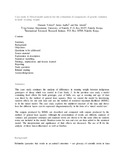| dc.contributor.author | Yobera, D | |
| dc.contributor.author | Audho, J | |
| dc.contributor.author | Aduda, E | |
| dc.date.accessioned | 2015-06-22T15:24:21Z | |
| dc.date.available | 2015-06-22T15:24:21Z | |
| dc.date.issued | 2011 | |
| dc.identifier.citation | Biometrics and Research Methods Teaching Resource Case Study;4 | en_US |
| dc.identifier.uri | https://cgspace.cgiar.org/handle/10568/10364 | |
| dc.identifier.uri | http://hdl.handle.net/11295/85441 | |
| dc.description.abstract | This case study continues the analysis of differences in weaning weight between indigenous
genotypes of sheep which was started in Case Study 3. In the previous case study a model
containing fixed effects for lamb genotype, year of birth, sex, age at weaning and age of dam
was fitted by the method of general least squares. Here we extend the model by introducing
random effects for sire and dam and use the method of restricted maximum likelihood (REML)
to fit the mixed model. The case study explores the multilevel structure of the data and shows
how the different layers can be expressed diagrammatically in the form of a ´mixed model tree´.
The outputs produced by REML are described and compared with outputs produced by the
method of general least squares. Although the presentations of results are different, analyses of
variance and parameter estimates and standard errors are shown to be the same when no random
terms are included in the model. Random terms for ram and ewe are then added to the statistical
model. The interpretation and significance of their effects are discussed. The use of R for the
analysis of these data is illustrated as well as GenStat. | en_US |
| dc.language.iso | en | en_US |
| dc.title | Mixed model analysis for the estimation of components of genetic variation in lamb weaning weight | en_US |
| dc.type | Book chapter | en_US |
| dc.type.material | en_US | en_US |

